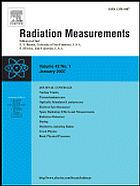|
Literature / Source Database:
Radiation Measurements
| Title (short) |
Radiat. Meas. |
| Languages |
English |
| First year |
1977 |
| Impact factor |
1.071 |
| Editor |
E.V. Benton, E.R. Benton, F. d'Errico |
|
|

|
Status
active
Indexing
Applied Health Physics Abstracts, BIOSIS, Chemical Abstracts, Current Contents/Physics, Chemical, & Earth Sciences, Current Contents/SciSearch Database, Current Contents/Social & Behavioral Sciences, Engineering Index, Health and Safety Science,
Subject

Source type
Journal
Publisher
ISBN ISSN
1350-4487
First volume
23
Last volume
42
Homepage
| Resources |
|
Availability |
|
|
|
|
|
| Text PDF |
 |
free access |
 |
| Text Html |
 |
for subscriber |
 |
| References |
 |
not available |
 |
| Abstracts |
 |
|
|
| TOC |
 |
|
|
|
|
|
|

Description
Radiation Measurements provides a forum for the presentation of the latest developments in the broad field of ionizing radiation detection and measurement and publishes original papers on both fundamental and applied research.
Traditionally the journal has covered methods that comprise solid state nuclear track detectors; spontaneous and stimulated luminescence (including scintillating materials, thermoluminescence, and optically stimulated luminescence); electron spin resonance of natural and synthetic materials; nuclear magnetic resonance (including ferrous sulfate and polymer gels), and superheated emulsions (including superheated drop and bubble detectors). Physics, design and performance of radiation measurements, including computational modelling such as Monte Carlo simulations, are of relevance to the journal, as well as studies of energy-transfer phenomena, track physics and microdosimetry. Measurements and calculations of fundamental physical data, such as cross sections, reaction yields and attenuation coefficients, are acceptable within studies of radiation detection and dosimetry.
Applications of interest to the journal are: personal dosimetry (including dosimetric quantities, active/electronic and passive monitoring techniques for photon, neutron and charged-particle exposures); environmental dosimetry (including radon measurements where they introduce methodological advances, predictive models, or detailed and original maps of complete or unusual geographical/geological regions); cosmic and high-energy radiation measurements (including dosimetry, space radiation effects, and single event upsets); dosimetry-based archaeological and geological dating; accident and retrospective dosimetry (including activation detectors). Papers that present novel detection techniques and applications such as illicit radiological and nuclear material detection (including contraband interdiction and safeguards verification) are also sought. Review articles are periodically solicited by the Editors.
|